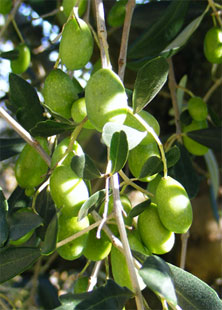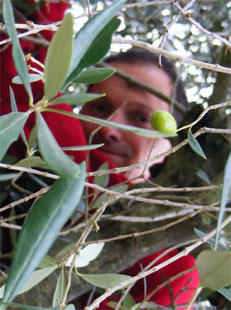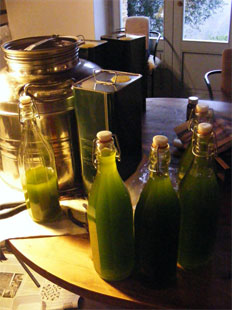CdP
21 November 2010
When autumn begins and the fields and woods fill up – at weekends at least – with the sound of hunters, I stomp around feeling aggrieved. But then come the weeks when the sounds of human activity take on another tone; olive pickers are out in force, and the sound of them calling to each other as they move from tree to tree is infinitely more welcome.
There really is a particular olive-picking tone. I think it’s something to do with trying to carry on a conversation between four or five people doing different tasks – net-spreading, combing fruit off branches, picking leaves and branch debris out of plucked fruit – in different spots around an olive grove. You need to use a special pitch to be heard by all, and olive-picking is, above all, social.
There are odd rituals about the thing. For a start, everyone (except us, I’m afraid, with our nasty aluminium) seems to use odd home-made-looking wooden ladders: very picturesque when left propped against gnarled trunks but a nightmare to heave from tree to tree. What I’ve seen less of this year is the bands of old ladies, broad-hipped and calf-length-skirted, their hair bound up in scarves and kerchiefs to keep bits of bug and vegetation from getting into it: the effect is fantastically timeless. They would have looked like that in the 1950s; quite possibly they would have looked like that in the 1920s. Maybe I’ve been travelling the wrong roads recently, or maybe those ageless ladies are simply too old for the job. Certainly, most people round up the nearest available eastern Europeans to help in the trees, and they somehow don’t make such a pretty picture in their nylon track suits from the bargain aisle in Lidl. It’s a sad bit of progress.
Our olives have been deceptive, looking plump and ready when in fact they – like all the rest of the produce this year – were about two weeks behind. But there were some lovely days three weeks ago and many people got stuck in. The yield then was around 10-12 litres per 100kg of olives… a hopelessly small amount. I spent a glorious Saturday last week up at J&ML’s, in shirt sleeves, enjoying the sun, trying not to get my nose burnt; and a slightly less sunny but pleasant nonetheless Sunday down here. By the time we got our three basketfuls in, and put them together with J&ML’s, the conditions had driven the yield up: we scraped 15.5 litres to the quintale. Quite respectable after all.
I was talking about this with Mario Stella, the poor hassled oil-press owner, as I waited for ours to go through the mill last Wednesday. He looked like he hadn’t slept for days, and no doubt hadn’t. All around the mill, large-scale farmers and people with a few trees were doing terrifying manoevres with battered Fiat Pandas or massive tractors with trailers attached. Mario’s son (or whoever the young boy is who works there) was darting around between them all on the little fork-lift, bringing vast crates of olives to tip them into the hopper. And everyone was eagle-eyed, on the look-out for queue-jumpers and advantage-takers. Barely controlled chaos.
Rain was forecast (and fell) for the following few days. That, Stella said, would drive the yield straight back down to where it had started. It’s an odd idea: it rains, the olives absorb water and swell and look very impressive but don’t have time or conditions to transform that water into oil. The water gets spun off as the oil goes through the press. So when you weigh the olives pre-pressing, you’re weighing waste water. The litre of oil per hundredweight of olive ratio plunges.
Our oil is, of course, fantastic. The very best. Everyone always thinks that theirs is. Which reminds me I must decant the oil from the stainless steel container I have here which belongs to J&ML. So much that needs to be done.
******
Every autumn we seem to have a brush with truffles and truffle ‘hunting’. This year it took place not far away at all, in Parrano. The set-up for the hunt was the same as last year in Castel Monastero: same strange PR woman (a six foot four Argentinian with a boxer’s jaw), same rather bored-looking truffle hunters dragging their dogs across to the spots where the truffles had been carefully concealed not long before. All that was missing on this occasion at the Principato di Parrano were all our particular friends from the foreign press (they were there en masse at Castel Monastero last year: this year almost all the other junket-ers were Italian hacks) and also any clear picture of what on earth we had been invited for.
The property is immense: 1200 hectares plus a castle and about 100 casali scattered around the place. It was from one of these casali that the loopy Junio Borghese and his merry men set off for their abortive Fascist coup attempt in December 1970 (“ma non è andato a buon fine” – it didn’t go very well, Parrano’s new owner Roberto Soldera, a man who would seem to model himself on Il Duce, told me.) Then there’s the castle itself – a ‘genuine’ (though clearly thoroughly made-over) pile from the year 1110 or thereabouts. It was here that Vittorio Valletta, the man who held the reins at Fiat for many years while Gianni Agnelli sowed his wild oats, lived. Valletta, too, had questionable links with the extreme right. All in all, a strange little oasis of right-wing extremists in la rossa Umbria.
So why were we there? Well, that’s what we kept trying to get them to say. The castle is clearly set up to be a hotel. The spa, I have to say, is quite something and uses the estate’s many thermal springs of varying temperatures. But there’s no real staff: everyone there had clearly been shipped in for the occasion. And there’s no real plan either: L was told to get back to them in February and they might have a clearer picture.
Meanwhile, we ate white truffles until I never wanted to see another in my life (did I not say this last year too?) and brought a truffly souvenir home. L talked to one of the truffle hunters, and asked him to come and let his dogs sniff around our fields. He seemed quite enthusiastic at the prospect: perhaps because it would be a genuine hunt rather than one staged for journalists? But so far he hasn’t shown up. Shame. Our situation is just right; lots of water and willows, hazels and oak trees growing near the water but bordering open fields. It would be fun to find we were sitting on a white truffle gold mine.





